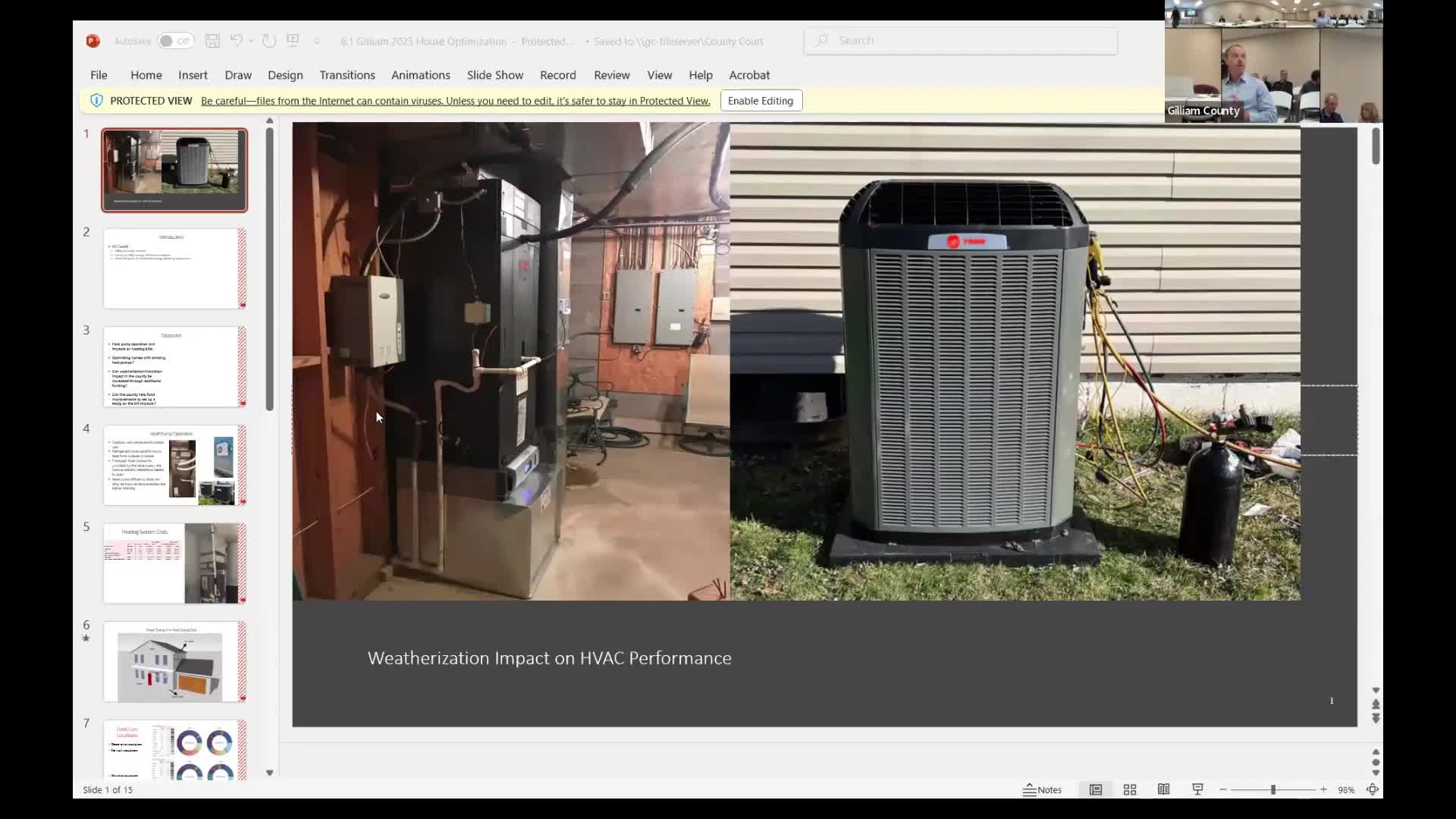Gilliam County resident urges small weatherization pilot to cut winter bills for heat‑pump homes
October 16, 2025 | Gilliam County, Oregon
This article was created by AI summarizing key points discussed. AI makes mistakes, so for full details and context, please refer to the video of the full meeting. Please report any errors so we can fix them. Report an error »

Eli Padil, a Gilliam County resident and energy efficiency practitioner, asked the court to consider funding a small pilot to weatherize two houses heated with heat pumps and measure the effect on energy bills and peak grid demand.
Padil described how poorly insulated homes can force heat pumps to rely on expensive electric resistance backup heat when outdoor temperatures drop and said insulation, duct sealing and heat‑pump commissioning can substantially lower energy use. He presented example cost ranges for weatherization work of roughly $7,000 to $15,000 per house and said incentives from Energy Trust of Oregon and other programs can offset some costs depending on fuel type and income.
Padil asked the court to consider underwriting two pilot homes — preferably single‑family structures without complex repair needs or knob‑and‑tube wiring — to gather data on reductions in winter bills and to produce a case study for rural Oregon communities. He said the pilot would show whether targeted weatherization reduces the amount of electric resistance backup heat a home needs, lowering bills and reducing peak demands on the local grid.
County staff response and next steps: Commissioners and staff discussed funding options and potential program partners. Staff noted the county’s nonprofit affiliate, CenturyCorp (a 501(c)(3) used by the county to access grants), and suggested the Pioneer CDC, senior services and community nonprofit partners could be explored as sponsors or fiscal agents for a small program. Commissioners asked staff to look into eligibility and whether existing state programs (including Oregon’s SHPO/Show programs and Energy Trust incentives) could be combined with county funds.
Padil said the total county funding request for two houses would likely be in the $15,000 to $23,000 range. Commissioners suggested staff investigate funding pathways and possible nonprofit partners and return with options for a program structure and legal/administrative feasibility.
Padil framed the proposed pilot as a long‑lived investment in housing stock that reduces annual energy bills and increases housing durability and affordability.
Padil described how poorly insulated homes can force heat pumps to rely on expensive electric resistance backup heat when outdoor temperatures drop and said insulation, duct sealing and heat‑pump commissioning can substantially lower energy use. He presented example cost ranges for weatherization work of roughly $7,000 to $15,000 per house and said incentives from Energy Trust of Oregon and other programs can offset some costs depending on fuel type and income.
Padil asked the court to consider underwriting two pilot homes — preferably single‑family structures without complex repair needs or knob‑and‑tube wiring — to gather data on reductions in winter bills and to produce a case study for rural Oregon communities. He said the pilot would show whether targeted weatherization reduces the amount of electric resistance backup heat a home needs, lowering bills and reducing peak demands on the local grid.
County staff response and next steps: Commissioners and staff discussed funding options and potential program partners. Staff noted the county’s nonprofit affiliate, CenturyCorp (a 501(c)(3) used by the county to access grants), and suggested the Pioneer CDC, senior services and community nonprofit partners could be explored as sponsors or fiscal agents for a small program. Commissioners asked staff to look into eligibility and whether existing state programs (including Oregon’s SHPO/Show programs and Energy Trust incentives) could be combined with county funds.
Padil said the total county funding request for two houses would likely be in the $15,000 to $23,000 range. Commissioners suggested staff investigate funding pathways and possible nonprofit partners and return with options for a program structure and legal/administrative feasibility.
Padil framed the proposed pilot as a long‑lived investment in housing stock that reduces annual energy bills and increases housing durability and affordability.
View full meeting
This article is based on a recent meeting—watch the full video and explore the complete transcript for deeper insights into the discussion.
View full meeting
